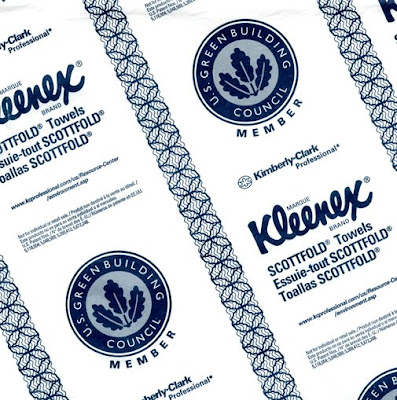or
How the USGBC Knows Their Marketing Efforts Have Succeeded
Claims of rampant greenwashing by manufacturers abound, but I haven't seen anything about the emerging greendrying phenomenon that recently showed itself in the bathrooms at my office. Here's a scan of the packaging wrapping the towels:

What surprised me most about this is that nowhere on the packaging does it say anything about the fact that these towels use at least 40% post-consumer recycled content, with Kleenex deciding instead to use a USGBC member logo roughly twice the size of their own logo as the sole means for showing their green cred. I had to look online to even verify that these towels were indeed green in some manner.
Before you start leaving comments, yes, I have seen the post in Treehugger about the relative merits of using paper towels vs. air dry machines. In this particular study, air dry won, but there seems to be some better options in the comments of that post.





10 comments:
Is there any requirement to being a member besides $$$? I mean they don't kick you out if you do not meet some criteria. I guess the "brand" recognition of USGBC is very powerful - even more than any actual information.
Chris, there are no other requirements other than just paying them hundreds of dollars. To many brands, it's an easy way to say their green, while the products or manufacturing leave much to be desired.
It's also important to note that as green continues its course into the mainstream, green messaging is becoming diluted. Most consumer new to the idea of buying green rely on third party certification for guidance.
Something like the USGBC logo does the job, with most people just assuming there are standards in place that this product is living up to.
I don't know if I'd call this a success for the USGBC's marketing efforts. As has been pointed out, *any* company can get a USGBC membership, even a forestry company that logs solely old growth timber. The ironic thing here is that the USGBC certified buildings, not products; but yet here we have a product associating itself with a "green" logo, giving the impression that it is somehow sustainable. 40% recycled content is one thing, but misleading consumers is another thing entirely.
Per USGBC terms of use for logo on product packaging.
Member Logo on Product Packaging
USGBC does not review, certify, or endorse products. As such, the Member Logo may
not be used to indicate any kind of endorsement by USGBC of any product or service,
to indicate that any offi cial status for any product or service has been conferred by or is
otherwise associated with USGBC, or to show any kind of relationship with USGBC other
than to signify the company is a USGBC member.
The Member Logo may be placed on product packaging under the following terms and
conditions:
The logo must be positioned spatially near/adjacent to the name of the member company
(not the brand or product name that is featured on the packaging).
The logo must not be printed larger than a relative height of 1.50 inches or smaller than
0.5 inches high.
The packaging must include the following acknowledgement:
"The 'USGBC Member Logo' is a trademark owned by the U.S. Green Building
Council and is used by permission. The logo signifi es only that __[COMPANY
NAME]__ is a USGBC member; USGBC does not review, certify, or endorse the
products or services off ered by its members."
Placement of the Member Logo on product packaging must be reviewed and
approved by the USGBC Marketing Department: marketing@usgbc.org
I sell commercial cleaning supplies - yep I sell TP for a living. I agree that greenwashing is a HUGE problem in the supplies and services industry. I am not a marketing expert so I will leave the placement and size of logo to the smart people. Here is some information on what I believe is your product. (Let me also disclose that I sell KC as a distributor - as well as their competitors products).
It looks like you may be using the ScottFold M Towel (01980). This product meets EPA standards with a minimum of 40% post consumer waste. The packaging was also changed from last year for the current larger case size to reduce packaging waste.
I hope everyone understands that 3rd parties charge a ton of money to "certify" their product - and many do so. The EPA provides guidelines (acceptable for LEED projects) that do not require the mfg to increase the cost of the product.
Please also keep in mind this is what we affectionately call a commodity product. Commodities are very sensitive to price constraints (thus mfg are constantly seeking ways to reduce cost/waste). It is just as easy for customers to buy their stuff overseas at half the price.
As a side note your employer should look at "roll" towels which on average saves 30% of waste.
You should just stop washing your hands.
Don't let the CDC hear you say that.
Interesting diversion Sally started, but I've heard a lot of grumbling (random NPR stories and such I don't care to find and cite properly) about concerns that rampant use of antibacterial soap not only weakens our natural immune system but yields drug/chemically resistant bacteria as well. Maybe I'm spreading junk science here, but intuitively it makes sense.
Careful what you ask for.
http://www.cdc.gov/ncidod/eid/vol7no3_supp/levy.htm
More info than I'm sure you wanted. I was surprised to read in here that there's also a suspicion that reducing childhood infections may increase allergies. Else where I've read that people are trying to ban anti-bacterial products to the public so that hospital use of them is more effective. Now we're really off topic.
Perhaps Kleenex should consider using USGBC's most updated logo if they are going to brag about the affiliation...
Post a Comment